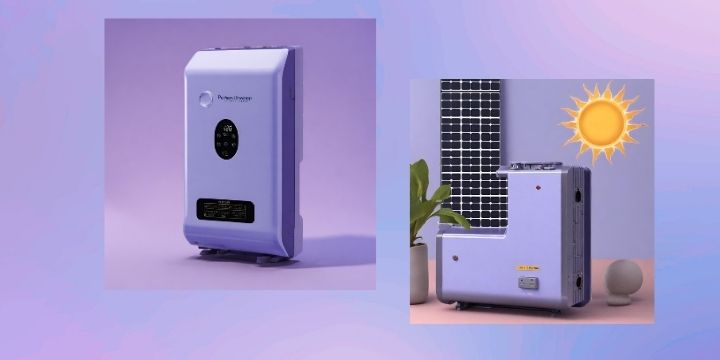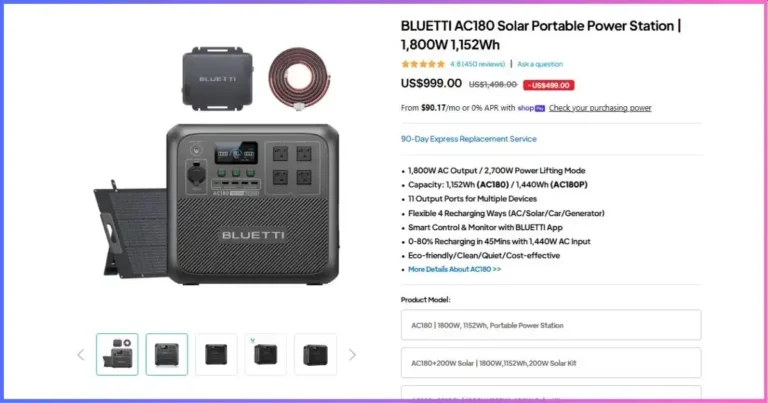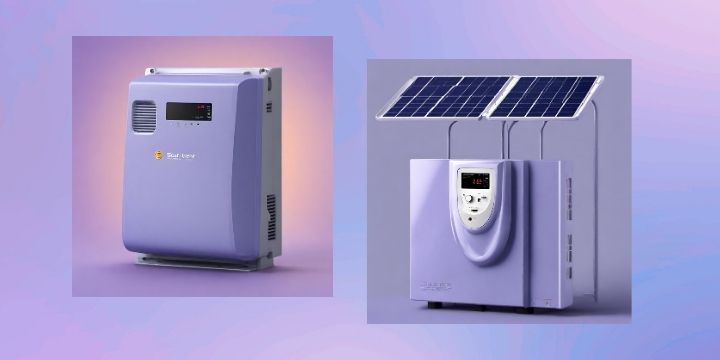Essential Solar Inverter Maintenance: The Monthly Checklist Pros Use

As a solar system owner, the performance of your solar inverter is critical to maximizing the benefits of your investment. Neglecting routine maintenance of this key component can significantly reduce system efficiency and lifespan, costing you money in the long run.
To keep your inverter running at peak performance, there are a few essential checks you should perform each month. Following the pro tips in this article will help ensure your solar inverter provides clean, renewable energy for years to come.
Make the most of the investment in your home and the planet by adding this short solar inverter maintenance checklist to your monthly routine.
Reliable Power Anywhere
Experience the freedom of portable power with Bluetti's cutting-edge solar generators and power stations. Whether you're camping, preparing for emergencies, or reducing your reliance on the grid, Bluetti offers reliable, eco-friendly solutions that keep you powered up anywhere.
Explore Bluetti Products NowWhy Regular Solar Inverter Maintenance Is Crucial
Regular maintenance of your solar inverter system is crucial to ensure maximum efficiency and return on your investment. Without routine inspections and servicing, inverter failure is likely, resulting in reliance on grid power and higher utility bills.
Monthly Visual Inspections
At a minimum, conduct a visual inspection of your inverter system once a month. Check that the inverter is securely mounted, fans are operating properly without excessive noise, and all wiring is intact with no visible damage. Clear away any debris around the inverter that could block airflow or present a fire hazard.
Performance Monitoring
Most inverters allow for remote performance monitoring through an app or web portal. Check system statistics like inverter input/output power, temperature, and error alerts at least monthly to catch any drops in performance early on. Underperforming inverters require servicing to prevent complete failure.
Professional Servicing
Have a certified solar technician perform a professional checkup of your inverter system once every 6-12 months. The technician will test all inverter components, update any firmware, clean air filters and heat sinks, and perform diagnostics to determine if any parts need replacement.
Go Green with Bluetti
Take a step towards sustainability with Bluetti’s advanced solar technology. From high-capacity power banks to efficient solar panels, Bluetti helps you harness the power of the sun to reduce your carbon footprint without compromising on performance.
Shop Sustainable Power SolutionsThough DIY maintenance saves money, professional servicing helps maximize inverter lifespan and system efficiency.
To get the most out of your solar investment through high inverter performance and reliability, implement a regular maintenance schedule. With ongoing inspections, monitoring, and professional servicing, your inverter system will provide sustainable power for years to come.
Monthly Visual Inspections to Spot Issues
As a solar professional, conducting regular maintenance on your customers’ inverters is critical to ensuring optimal, uninterrupted performance and a long lifecycle. Monthly visual inspections allow you to identify issues early and take corrective action.
Inverter Appearance and Environment
Inspect the inverter casing for any visible damage like cracks or dents and the surrounding area for proper ventilation. Look for any signs of overheating on internal components. Ensure the inverter is securely installed in a cool, dry location away from flammable objects.
Connections and Wiring
Examine all wiring and connections for damage or corrosion and ensure they are securely fastened. Tighten any loose wire nuts or terminals. Check that all grounding conductors are properly connected.
Monitoring and Alerts
Review the inverter display and any connected monitoring interfaces for error codes or alerts and take appropriate action. Ensure all communication equipment like Ethernet cables, antennas, and modems are properly connected and secured.
General Component Functionality
Power the inverter on to verify all internal components like circuit boards, fans, and switches are functioning properly. Listen for any strange noises. Check that all fuses and breakers are intact.
Conducting routine maintenance and proactively monitoring your solar inverters will minimize downtime, reduce long-term repair costs, and ensure optimal system performance and output.
Power Your Adventures
Don't let power outages or off-grid adventures slow you down! Bluetti's portable solar-powered solutions are designed for convenience and efficiency, making them the perfect companion for any lifestyle.
Discover Bluetti's Portable PowerCleaning the Inverter to Prevent Overheating
To prevent overheating and ensure optimal performance, your solar inverter requires regular cleaning and maintenance. As a key component in your photovoltaic system, overheating can lead to reduced efficiency and shorter equipment lifespan.
Inspect Air Vents and Fans
The inverter uses built-in fans and vents to properly cool internal components. Examine all air vents and fans to ensure they are clear of any debris or blockages. Use a can of compressed air to blow out any dust accumulation.
Verify that all fans are spinning properly and move air effectively. Replace any malfunctioning or worn-out fans immediately.
Wipe Down Exterior Casing
The exterior casing protects internal parts from weather and environmental damage. Wipe down the entire exterior casing with a damp, lint-free cloth to remove any built-up dirt or grime.
Pay extra attention to air vents and louvers. For stubborn stains, you can use a mild solvent like isopropyl alcohol. Ensure the casing is fully dry to prevent water damage.
Check All Connections
Inspect all cable connections to confirm they are secure and show no signs of damage, corrosion, or overheating. Tighten any loose connections and replace damaged cables and connectors.
Secure connections are necessary to provide consistent power to and from the inverter. Loose or faulty connections can lead to power fluctuations, arcing, and fire risk.
Record Voltage and Amperage
Using a multimeter, record the voltage and amperage entering and exiting the inverter. Compare the readings to the inverter’s specifications to ensure all levels remain within the normal operating range.
Abnormal readings could indicate issues with the inverter or other components in the system. Consult a solar professional if you notice a significant change in levels.
Checking Connections and Wiring for Faults
One of the most important items on your monthly solar inverter maintenance checklist should be inspecting all connections and wiring for any faults or damage. As with any electrical system, loose or improperly connected wires can pose serious safety and performance issues.
Checking Terminal Connections
Double-check that all wires are securely fastened to the correct terminals. Loose connections can cause system faults, and reduced power output, and may even lead to electrical fires if left unaddressed. Tighten any loose connections with an insulated wrench and check that all wires are securely in place.
Inspecting for Fraying or Damage
Carefully examine all wiring, cables, and conduits for any signs of fraying, cracking, or damage. Exposure to environmental elements like sunlight, heat, and moisture over time can degrade wiring and connections. Replace any damaged wiring immediately to avoid safety hazards and power loss.
Grounding Connections
Ensure all grounding conductors are properly attached. Grounding provides a safe path for stray electrical current to flow to the ground, preventing electric shock. Loose or improperly connected grounding conductors defeat this safety mechanism and should be remedied right away.
Conduit and Raceways
Inspect all conduits, raceways, and their connections for damage or faults. Conduits and raceways protect wires from environmental damage and must be intact to serve their purpose. Look for any cracking, dents, or separation from connections and repair or replace as needed.
Labeling
Double-check that all wiring, terminals, and raceways are properly labeled to avoid confusion. Correct labeling makes maintenance, troubleshooting, and repairs vastly easier for you or any technicians. Re-label anything that is missing, damaged, or unclear.
Following these steps to thoroughly check all connections and wiring in your solar inverter system on a monthly basis will help ensure optimal, safe performance and long operational life. Be sure to also reference your inverter’s manual for any specific maintenance recommendations from the manufacturer.
Monitoring Performance Data and Output
Monitoring your solar inverter’s performance data and energy output is essential to ensure maximum efficiency and return on your investment. On a monthly basis, check the following:
Production
Review your inverter’s power production to confirm it is operating as expected for the time of year and weather conditions. Compare current totals to the same period last year and your average monthly production. Significant drops can indicate issues with one or more panels or parts needing replacement.
Efficiency
Check your inverter’s efficiency rating, which indicates how much of the energy from your panels is converted to usable electricity. Most inverters are 95-98% efficient – anything below 90% warrants further investigation. Lower efficiency reduces your energy yield and financial savings.
Error Codes
Scan for any error codes, which signal a malfunction or fault in the inverter that requires attention. Error codes vary by inverter brand and model; check your owner’s manual for details and next steps. Unresolved error codes can potentially damage components or void product warranties if left unattended.
Software Updates
See if any free over-the-air software or firmware updates are available for your inverter. Updates patch security vulnerabilities, fixes known issues and improves performance and monitoring capabilities. Install updates as recommended by your inverter manufacturer.
Cleaning
For maximum efficiency, inverters require periodic cleaning. Gently vacuum or blow away any built-up dust on the inverter, cables, and other exterior parts.
Ensure all ports, plugs, and connections are free of debris. Wipe down the exterior with a damp, soft cloth to remove stubborn dirt or stains. Never use harsh chemicals, abrasive cleaners, or solvents.
Performing regular maintenance and monitoring on your solar equipment helps safeguard your investment for maximum energy production and savings for years to come.
Schedule time each month to check on your inverter’s performance and output using the criteria above. Take action promptly on any issues to get your system back to peak efficiency.
Disclosure: We may earn commission for purchases that are made by visitors on this site at no additional cost on your end. All information is for educational purposes and is not intended for financial advice. Read our affiliate disclosure.






